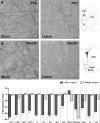Differential roles for cortical versus sub-cortical noradrenaline and modulation of impulsivity in the rat
- PMID: 27744551
- PMCID: PMC5203835
- DOI: 10.1007/s00213-016-4458-8
Differential roles for cortical versus sub-cortical noradrenaline and modulation of impulsivity in the rat
Abstract
Rationale: Atomoxetine is a noradrenaline re-uptake inhibitor licensed for the treatment of adult and childhood attention deficit hyperactivity disorder. Although atomoxetine has established efficacy, the mechanisms which mediate its effects are not well understood.
Objectives: In this study, we investigated the role of cortical versus sub-cortical noradrenaline by using focal dopamine beta hydroxylase-saporin-induced lesions, to the prefrontal cortex (n = 16) or nucleus accumbens shell (n = 18).
Methods: Healthy animals were tested by using the forced-choice serial reaction time task to assess the impact of the lesion on baseline performance and the response to atomoxetine and the psychostimulant amphetamine.
Results: We observed attenuation in the efficacy of atomoxetine in animals with lesions to the nucleus accumbens shell, but not the prefrontal cortex. Amphetamine-induced increases in premature responses were potentiated in animals with lesions to the prefrontal cortex, but not the nucleus accumbens shell.
Conclusions: These data suggest that noradrenaline in the nucleus accumbens shell plays an important role in the effects of atomoxetine. Under these conditions, prefrontal cortex noradrenaline did not appear to contribute to atomoxetine's effects suggesting a lack of cortical-mediated "top-down" modulation. Noradrenaline in the prefrontal cortex appears to contribute to the modulation of impulsive responding in amphetamine-treated animals, with a loss of noradrenaline associated with potentiation of its effects. These data demonstrate a potential dissociation between cortical and sub-cortical noradrenergic mechanisms and impulse control in terms of the actions of atomoxetine and amphetamine.
Keywords: Amphetamine; Atomoxetine; Impulse control; Noradrenaline; Nucleus accumbens; Prefrontal cortex.
Conflict of interest statement
Compliance with ethical standards Funding Funding for this research was provided by a Medical Research Council New Investigator grant (Ref G0700980) awarded to E.S.J.R. Conflict of interest The authors declare no conflict of interest.
Figures




Similar articles
-
Effects of atomoxetine on attention and impulsivity in the five-choice serial reaction time task in rats with lesions of dorsal noradrenergic ascending bundle.Prog Neuropsychopharmacol Biol Psychiatry. 2015 Jan 2;56:81-90. doi: 10.1016/j.pnpbp.2014.08.007. Epub 2014 Aug 21. Prog Neuropsychopharmacol Biol Psychiatry. 2015. PMID: 25151304
-
Norepinephrine and dopamine modulate impulsivity on the five-choice serial reaction time task through opponent actions in the shell and core sub-regions of the nucleus accumbens.Neuropsychopharmacology. 2012 Aug;37(9):2057-66. doi: 10.1038/npp.2012.53. Epub 2012 Apr 18. Neuropsychopharmacology. 2012. PMID: 22510726 Free PMC article.
-
Chronic atomoxetine treatment during adolescence decreases impulsive choice, but not impulsive action, in adult rats and alters markers of synaptic plasticity in the orbitofrontal cortex.Psychopharmacology (Berl). 2012 Jan;219(2):285-301. doi: 10.1007/s00213-011-2419-9. Epub 2011 Aug 2. Psychopharmacology (Berl). 2012. PMID: 21809008
-
Catecholamine influences on prefrontal cortical function: relevance to treatment of attention deficit/hyperactivity disorder and related disorders.Pharmacol Biochem Behav. 2011 Aug;99(2):211-6. doi: 10.1016/j.pbb.2011.01.020. Epub 2011 Feb 2. Pharmacol Biochem Behav. 2011. PMID: 21295057 Free PMC article. Review.
-
Atomoxetine: a review of its use in attention-deficit hyperactivity disorder in children and adolescents.Paediatr Drugs. 2009;11(3):203-26. doi: 10.2165/00148581-200911030-00005. Paediatr Drugs. 2009. PMID: 19445548 Review.
Cited by
-
Theory of visual attention (TVA) applied to rats performing the 5-choice serial reaction time task: differential effects of dopaminergic and noradrenergic manipulations.Psychopharmacology (Berl). 2023 Jan;240(1):41-58. doi: 10.1007/s00213-022-06269-4. Epub 2022 Nov 25. Psychopharmacology (Berl). 2023. PMID: 36434307 Free PMC article.
-
Development of a novel rodent rapid serial visual presentation task reveals dissociable effects of stimulant versus nonstimulant treatments on attentional processes.Cogn Affect Behav Neurosci. 2024 Apr;24(2):351-367. doi: 10.3758/s13415-023-01152-x. Epub 2024 Jan 22. Cogn Affect Behav Neurosci. 2024. PMID: 38253774 Free PMC article.
-
Adaptive aspects of impulsivity and interactions with effects of catecholaminergic agents in the 5-choice serial reaction time task: implications for ADHD.Psychopharmacology (Berl). 2021 Sep;238(9):2601-2615. doi: 10.1007/s00213-021-05883-y. Epub 2021 Jun 9. Psychopharmacology (Berl). 2021. PMID: 34104987 Free PMC article.
-
Optogenetic and pharmacological interventions link hypocretin neurons to impulsivity in mice.Commun Biol. 2023 Jan 19;6(1):74. doi: 10.1038/s42003-023-04409-w. Commun Biol. 2023. PMID: 36658362 Free PMC article.
-
The Current State of Pharmacological Treatments for Cannabis Use Disorder and Withdrawal.Neuropsychopharmacology. 2018 Jan;43(1):173-194. doi: 10.1038/npp.2017.212. Epub 2017 Sep 6. Neuropsychopharmacology. 2018. PMID: 28875989 Free PMC article. Review.
References
Publication types
MeSH terms
Substances
Grants and funding
LinkOut - more resources
Full Text Sources
Other Literature Sources
Molecular Biology Databases

